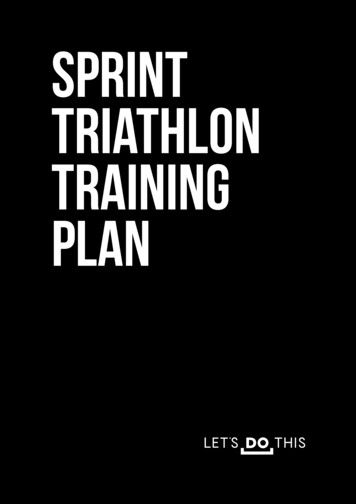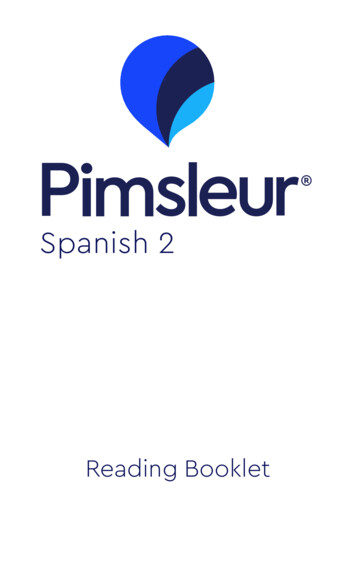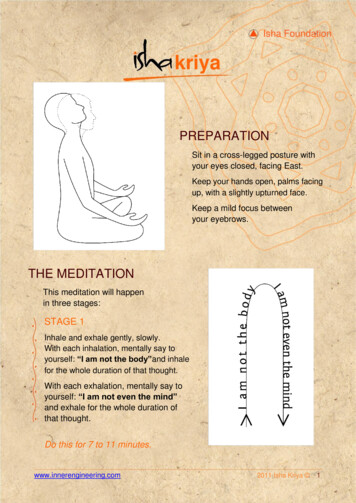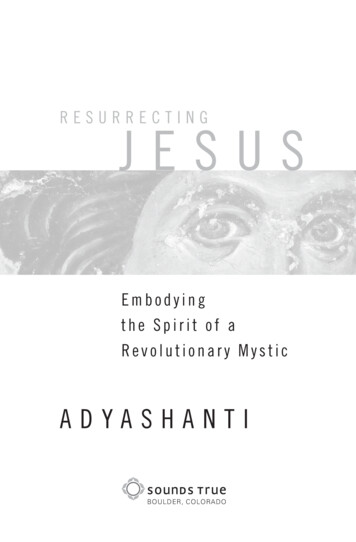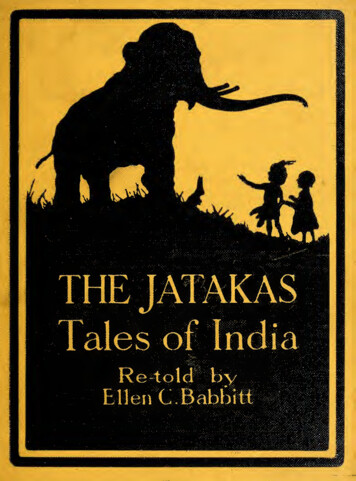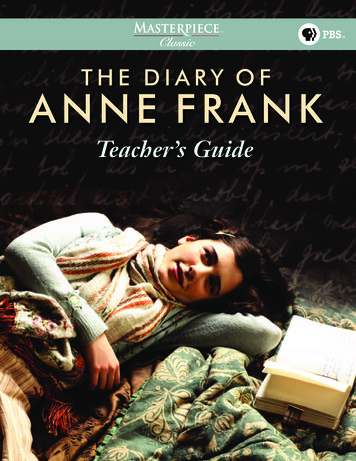
Transcription
Teacher’s Guide
Teacher’s GuideTA M S I N G R E I G, E L L I E K E N D R I C K , A N D I A I N G L E NA S E DITH, A N N E, A N D OT TO FR A N K . 2010 WGBH EDUCATIONAL FOUNDATION Darlow Smithson Productions for MasterpieceTable of Contents3Introduction5Setting the Scene: Historical Context9Student Handout: Key Dates10Using the Film The Diary of AnneFrank in the Classroom13Student Handout: MakingHistory Personal14Reading Closely: Revised Passagesin Focus15Student Handout: RevisedPassages in Focus16Exploring the Diary Form18An Interview with AuthorFrancine Prose20Recommended Resources23Creditspbs.org/masterpiece/annefrank2
IntroductionO Darlow Smithson Productions for Masterpiecen April 11, 2010—Holocaust Remembrance Day—a bold new adaptationof The Diary of Anne Frank will premiere on Masterpiece Classic on PBS.In contrast to previous television and film versions, which have relied primarilyon biographies as their source material, this new adaptation features Anne Frank’s uneditedwords, drawn directly from her diary. Screenwriter Deborah Moggach also receivedpermission to use passages of the diary previously deleted by the family. To further enhancethe film’s authenticity, the production team painstakingly recreated the secret Amsterdamannex where Anne and her family hid from the Nazis between 1942 and 1944.Reinterpreting a Classic“ I want to be true to the realgirl .During those two years,cramped into that tiny space,Anne grew and changedprofoundly. She deepened inspirit, she discovered herself asa writer, she pondered goodand evil and questioned thevery meaning of being human.”SCR EEN W R ITER DEBOR A H MOGGACHThe Diary of Anne Frank has become one of the world’s most widely read works ofnonfiction after the Bible. In adapting this classic for a new generation, screenwriterDeborah Moggach set out to show young viewers that Anne was a “thoroughly modernteenager—similar in many ways to today”—who lived in anything-but-normal times.Moggach explains:Like many people, I read the diary when I was young. Now, on rereading it, I’m struck byhow contemporary Anne is obsessed with boys, with her looks rebellious, highly criticalof her mother. In other words, a thoroughly modern teenager. In past adaptations, she hasbeen somewhat sanctified—a bit cheeky and talkative maybe, but also over-sweet. I want tobe true to the real girl. Sure, she got on people’s nerves; but she was also full of life, her ownsternest critic and, above all, she made people laugh.About this GuideNote: The Diary of Anne Frankcontains coming-of-age scenesthat some viewers may findobjectionable. Be sure to previewthe film before showing it in class.The Diary of Anne Frank is frequently taught in middle school and high school, and manymaterials for teaching the book already exist. While the diary is often taught either as ahistorical document or as a literary work, this guide encourages students to look at it asboth. It is intended to provide middle school and high school teachers with strategies andmaterials that support classroom viewing and discussion of The Diary of Anne Frank, basedon a brand-new film version and new information about Anne’s family, life, and death.Discussion questions, activities, reproducible worksheets, and assignment ideas aresupplemented by an extensive listing of resources for further exploration. The guide aims tospark critical thinking and reflection on Anne Frank’s diary, both as a literary classic and asa rich and illuminating first-person account of life in hiding during World War II; morebroadly, the guide addresses the themes of prejudice, hate, hope, courage, and heroism thatsuffuse the diary. The guide also draws contemporary connections. Whether you use thisguide in conjunction with existing lesson plans or to develop a new approach to the diary,you will want to provide enough historical and literary context so that students have a firmfoundation on which to build their understanding.For students who have read The Diary of Anne Frank, the film offers an opportunity todeepen their appreciation of Anne Frank’s story and to consider the process by which abook is adapted for the screen; the film can also be used to introduce Anne Frank tostudents who have not read her diary. In social studies, history, English, and writing 2010 WGBH EDUCATIONAL FOUNDATIONpbs.org/masterpiece/annefrank3
courses, the film can serve as a key element within a larger unit on World War II,Holocaust studies, or coming-of-age literature; it can also be used as a resource withinunits on diversity, tolerance, and human rights.This guide has been developed in consultation with Facing History and Ourselves, aninternational educational organization that provides educators, students, and ordinarycitizens with the information and tools they need to examine the history of racism,antisemitism, and prejudice, and to link that history to the moral choices they confront intheir own lives. At the core of their work is the resource book Facing History and Ourselves:Holocaust and Human Behavior, (http://www.facinghistory.org/resources/hhb) whichexplores the consequences of hatred. Available for download, borrowing, or purchase, thisbook has helped students all over the world learn to recognize the consequences of bigotryand other forms of hatred. Facing History and Ourselves uses that book and relatedresources online and in in-person seminars and workshops. For more information, visithttp://facinghistory.org.This guide also utilizes many observations from the 2009 publication Anne Frank: TheBook, The Life, The Afterlife by Francine Prose. Prose argues that Anne Frank was not an“accidental author” but rather an extraordinary writer who crafted a deliberate work of artwhen she wrote and revised her diary. Not only does Prose’s research inform the reader asthey experience the book, but her observations help give context to some of the originalaspects of the film. An interview with Francine Prose is included in the guide and can helpstudents and teachers understand why Anne Frank’s story is still relevant today.Anne Frank Fonds, Basel/Anne Frank House, Amsterdam/Getty ImagesA N N E, ED ITH, A N DM A R G O T F R A N K , 19 3 3 . 2010 WGBH EDUCATIONAL FOUNDATIONpbs.org/masterpiece/annefrank4
SETTING THE SCENE:Historical ContextThe History of Antisemitism Darlow Smithson Productions for MasterpieceIn order to understand the Holocaust, is it helpful to explore the foundations ofantisemitism. Antisemitism is the unfounded hatred of Jews because they are Jews. Thathatred has had a long history in Europe and beyond. In earlier times, Jews were subject todiscrimination and persecution because they refused to accept the religion of the majority.Jews who converted, or so Christians claimed, were no longer considered outsiders; theybelonged. In the 1800s, a new form of antisemitism emerged. It was based on the falsenotion that humans are divided into separate and distinct “races,” and therefore people bornas Jews, regardless of their religious beliefs, belonged to an evil and dangerous “race.”Jews were now considered permanent outsiders.ANNE AND EDITH FR ANK (ELLIE KENDRICKA N D TA M S I N G R E I G ) H U R R Y T H R O U G HT H E S T R E E T S O F A M S T E R D A M TO T H ESECRET ANNEX.In times of crisis, Jews and other minorities have always been at risk, and the upheavalsafter World War I and the worldwide depression that began in the 1930s were noexceptions. In such times, many people are attracted to simple answers to complexproblems. Those answers often place the blame for the crisis on the “other” in the society.Antisemitism rose in nearly every nation in Europe and the Americas during those crises.The Rise of Nazi GermanyIn Germany, the claim that Jews were responsible for all of the nation’s problems wasfostered by groups like Adolf Hitler’s National Socialist, (Nazi) Party. In speech afterspeech, they insisted that the Jews were everywhere, controlled everything, and acted sosecretly that few could detect their influence. The charge was false, but after hearing it againand again, many came to believe it.“ Hiding.where would we hide?In the city? In the country?In a house? In a shack?When, where, how.?These were questionsI wasn’t allowed to ask.” A N N E F R A N K , I N A D I A R Y E N T R Y D AT E DJ U LY 8 , 1942Anne Frank House, Amsterdam/Getty ImagesFrom THE DIARY OF ANNE FRANK: THE DEFINITIVEEDITION by Anne Frank, edited by Otto H. Frank and MirjamPressler, translated by Susan Massotty, translation copyrights 1995 by Doubleday, a division of Random House, Inc. Used bypermission of Doubleday, a division of Random House, Inc.T H E E N T R A N C E TO T H E S E C R E T A N N E X WA SH I D D E N B Y T H I S M O V E A B L E B O O KC A S E . 2010 WGBH EDUCATIONAL FOUNDATIONpbs.org/masterpiece/annefrank5
Darlow Smithson Productions for MasterpieceM A R G O T, E D I T H , O T TO, A N D A N N E F R A N K ( F E L I C I T Y J O N E S , TA M S I N G R E I G, I A I N G L E N , A N D E L L I E K E N D R I C K )WA I T TO S E E I F T H E I R H I D I N G P L A C E H A S B E E N D I S C O V E R E D.In 1933 the Nazis took control of Germany. Once in power, they destroyed the nation’sdemocratic institutions and turned Germany into a police state. They were also determinedto protect Germans from the nation’s “racial enemies”—the Jews. In just six years, 400anti-Jewish measures were enacted. Each was designed to protect so-called “Aryan blood”from contamination with so-called “Jewish blood.” Otto Frank was among the firstGerman Jews to understand how dangerous this new government-led antisemitismreally was.Anne Frank and Her Family in Historical ContextIn 1933, Otto Frank left Germany and settled in Amsterdam, the capital of the Netherlands—a city with a reputation for religious tolerance. Otto Frank had this reputation inmind when, a year later, he made the decision to move his wife, Edith, and daughters,Margot and Anne, from their home in Frankfurt to Amsterdam. Like many other Jews,Otto Frank believed that by leaving Germany and emigrating to the Netherlands, he wouldbe transporting his family to safety and freedom. Although the Netherlands had its ownNazi Party, they were not yet a danger. So the Franks and other refugees from Germanysettled comfortably in their new home.In Amsterdam, Otto Frank set up a successful company that produced pectin, aningredient used to make jam. Within a year, the Franks had settled into an apartment,and Margot and Anne were attending school and flourishing in their new home.Then on September 1, 1939, the Nazis invaded Poland. Two days later, Britain and Francedeclared war on Germany. World War II had officially begun. By 1940, the Germansoccupied the Netherlands, Denmark, Norway, Belgium, Luxembourg, and France. In June1941, they invaded the Soviet Union. By December of 1941, the Germans had alsodeclared war on the United States.When Germany invaded the Netherlands in 1940, the Frank family once again found itselfliving under Nazi rule. Over the next two years, Jews were gradually removed from public 2010 WGBH EDUCATIONAL FOUNDATIONpbs.org/masterpiece/annefrank6
life. The first mass arrests took place in February 1941. In one of the first entries in herdiary, Anne described the conditions Jews faced in the Netherlands: Darlow Smithson Productions for MasterpieceOur freedom was severely restricted by a series of anti-Jewish decrees: Jews were required towear a yellow star; Jews were required to turn in their bicycles; Jews were forbidden to usestreetcars; Jews were forbidden to ride in cars, even their own; Jews were required to dotheir shopping between 3 and 5 p.m.; Jews were required to frequent only Jewish-ownedbarbershops and beauty parlors; Jews were forbidden to be out on the streets between 8 p.m.and 6 a.m.; Jews were forbidden to go to theaters, movies or any other forms of entertainment; . Jews were forbidden to visit Christians in their homes; Jews were required toattend Jewish schools, etc. [ JUNE 20, 1942]From THE DIARY OF ANNE FRANK: THE DEFINITIVE EDITION by Anne Frank, edited by Otto H. Frank and Mirjam Pressler, translated by Susan Massotty,translation copyrights 1995 by Doubleday, a division of Random House, Inc. Used by permission of Doubleday, a division of Random House, Inc.World War II and the Genocide of the JewsK AT E A S H F I E L D A S M I E P G I E S .Before the war began, the Germans had been intent on driving as many Jews as possibleout of Germany. By 1939, about half of all German Jews had left the country. Once the warbegan, emigration was no longer possible and it was then that the Germans turned tomurder. In 1940, the first massacres took place in Poland. Einsatzgruppen (mobile killingunits) now set out to destroy entire Jewish communities in Eastern Europe. They forcedmore than 1.5 million Jews from their homes, shot them, and then buried them in massgraves.By July 1941 Nazi officials were increasingly concerned about the “inefficiencies of theseoperations” and the psychological burden they placed on the killers. So they devised a more“complete solution of the Jewish question” by creating six death camps in Poland—Chelmno, Belzec, Sobibor, Treblinka, Majdanek, and Auschwitz-Birkenau. Of the 6 million Jewskilled during the Holocaust, approximately 2.7 million were murdered in the death campsby the time the war ended in 1945.THE GREATEST ENEMY: BYSTANDERSThe Holocaust survivor Miles Lermanhas aptly remarked on the significantrole bystanders played in allowing theHolocaust to occur. “A perpetrator isnot the most dangerous enemy,” Lermanargues. “The most dangerous part isthe bystander because neutrality alwayshelps the killer.”FA C I N G H I S TO R Y A N D O U R S E LV E S , A N N E F R A N KI N T H E W O R L D E X H I B I T: T E A C H E R ’ S G U I D E.B R O O K L I N E , M A : FA C I N G H I S TO R Y A N DO U R S E LV E S N AT I O N A L F O U N D AT I O N , I N C .,19 9 3 , P. 1Marion Pritchard, who rescued Jews inAmsterdam from the Nazis, said in aninterview, “[T]here were indeed somepeople who behaved criminally bybetraying their Jewish neighbors andtherefore sentencing them to death.There were some people who dedicatedthemselves to actively rescuing as manypeople as possible. Somewhere in betweenwas the majority, whose actions variedfrom the minimum decency of at leastkeeping quiet if they knew where Jewswere hidden to finding a way to helpwhen they were asked.”I N T E R V I E W I N C O U R A G E T O C A R E E D.B Y C A R O L R I T T N E R A N D S . M E Y E R S . P. 2 9 2010 WGBH EDUCATIONAL FOUNDATIONpbs.org/masterpiece/annefrank7
Anne Frank Fonds, Basel/Anne Frank House, Amsterdam/Getty ImagesT H E O F F I C E W O R K E R S W H O H E L P E D T H E R E S I D E N T S O F T H E S E C R E T A N N E X . F R O M R I G H T TO L E F T:M I E P G I E S , J O H A N N E S K L E I M A N , O T TO F R A N K , V I C TO R K U G L E R , A N D B E P V O S K U I J L .VIEWING IDEAHave students watch the first tenminutes of the film. Then askthem to analyze the reasonswhy the Frank family made thedecision to go into hiding.What were conditions like forJews in the Netherlands afterthe Nazi occupation? What newrestrictions did the family faceafter they moved into the annex?Ask students to imagine how itmight feel to have to changeyour life in so many ways simplybecause you are Jewish.Early in July 1942, Anne’s older sister Margot—who had just turned 16—was ordered bythe Nazis to report to a work camp. Otto Frank had anticipated this development monthsearlier and had secretly created a hiding place for his family in the back of the warehouseabove his office, with the help of a few trusted employees. The Franks moved into thishiding place, also known as the “secret annex,” on July 6, 1942. They were soon joined byanother family, whom Anne called the van Daans in her diary, and later by a dentist whomAnne called Albert Dussel. A group of helpers—including Miep Gies, who worked inOtto Frank’s office and who died in January, 2010 at the age of 100—risked their lives byoffering support to the Franks when they went into hiding. This group of eight lived in theannex for more than two years; it was here that Anne wrote hundreds of entries in herdiary, which she nicknamed “Kitty.” Anne addressed Kitty as if she were writing letters to aclose friend.On August 4, 1944, German police raided the annex after being tipped off to its existenceby an anonymous informant. The Franks, the van Daans, and Mr. Dussel were all sent toWesterbork, a Dutch transit camp (a temporary camp where Jews and other prisoners wereheld before they were shipped to forced labor or death camps), and from there deported toAuschwitz, a death camp.The Franks were on the last transport from the Netherlands to Auschwitz. Mrs. Frank wasmurdered there. As the Soviet troops advanced into Poland in the winter of 1945, theGermans shipped many inmates, including Anne and Margot, into Germany. Margot andAnne were transferred to a concentration camp called Bergen Belsen where they died oftyphus in March 1945 just weeks before the war ended. Of the eight Jews who had hiddenin the annex, only Otto Frank survived. He was instrumental in editing Anne’s diary and inbringing her story—and her remarkable talents as a writer—to the attention of theworld.—Adapted from Facing History and Ourselves, Brookline, MA: Facing History andOurselves National Foundation, Inc. Copyright 2010. 2010 WGBH EDUCATIONAL FOUNDATIONpbs.org/masterpiece/annefrank8
S T U D E N T H A NDOUTKey DatesW O R L D WA R I IANNE FRANK’S LIFEJune 12, 1929 Anne Frank is born in Frankfurt, Germany.January 30, 1933 The Nazi Party gainscontrol of Germany.September 1933 Otto Frank leaves Germany for Amsterdam.February 1934 Anne, her sister Margot, and their mother EdithSeptember 1, 1939 Nazis invade Poland.leave Germany and join their father Otto in Amsterdam,where he has set up a new company and found an apartment forthe family.September 3, 1939 France and Britain declare waron Germany.May 10, 1940 Germany invades theNetherlands and institutes a series of anti-Jewish laws.December, 1940 By this time, Germany occupies Denmark,Norway, Belgium, Netherlands, Luxembourg, and France.February 1941 The first mass arrests of Jews,communists, and intellectuals take place in Amsterdam.June 1941 Germany invades the Soviet Union.July 1941 By this time, the Nazis have created six deathDecember 11, 1941 Germany declares war onthe United States.Associated Presscamps in Poland—Chelmno, Belzec, Sobibor, Treblinka,Majdanek and Auschwitz-Birkenau.ANNE FR ANKMarch 1942 Approximately 20–25 percent of the 6 million Jewswho would die in the Holocaust have been killed.June 12, 1942 Anne receives an autograph book as a birthdaypresent and decides to use it as a diary.July 5, 1942 Margot, who has recently turned 16, is orderedto report to a work camp.July 6, 1942 The Franks go into hiding in response to Margot’sFebruary 1943 By now, 80–85 percent of the 6 million Jewswho would die in the Holocaust have been killed.deportation order. They remain in the secret annex formore than two years; during this period, Anne documents herexperiences in hiding through a series of diary entries.August 4, 1944 The secret annex is raided by German policeafter they are tipped off by an unidentified informant.September 3, 1944 Following a stay at the Westerbork transitcamp, the residents of the annex are all sent to Auschwitz.October 28, 1944 Anne and Margot are sent to Bergen-Belsenconcentration camp.March 1945 Anne dies of typhus at Bergen-Belsen.May 7, 1945 Germans surrender; World War II ends in Europe.She is 15 years old.1947 Anne Frank: Diary of a Young Girl is published in Amsterdam.1952 The Diary of Anne Frank is published in the United States. 2010 WGBH EDUCATIONAL FOUNDATIONpbs.org/masterpiece/annefrank
Using the Film The Diary ofAnne Frank in the ClassroomThe Diary of Anne Frank contains a number of rich and thought-provoking themes.Before viewing the film, invite students to select one of the themes listed belowand have them write freely about it for ten minutes, drawing material from life orliterature. Remind students to keep the theme they chose in mind as they watch the film. Darlow Smithson Productions for MasterpieceOnce students have finished watching the film, ask them to meet in small groups accordingto the theme they selected. Instruct each group to discuss how seeing the film informedtheir thinking about the theme they chose using the After Viewing questions to guide theirdiscussion.As a culminating activity, have each group report to the entire class on the key points theydiscovered by considering the film through these themes.TA M S I N G R E I G A S E D I T H F R A N K .“ Girls do grow up nowadays.Haven’t you noticed? We’renot going to be the same asyou. We’re going to live ourown lives and travel and havecareers.and we’re going tomake a better job of it thanyou grown-ups did.”A N N E F R A N K , I N A C O N V E R S AT I O NW IT H H ER MOT H ER ED IT HIn Search of SelfBefore Viewing How have you changed over the past two years? How would your friends or familymembers say you are different today than you were two years ago?After Viewing In what specific ways did Anne change during her months in the annex? To what extentare these changes in response to her situation in hiding, and to what extent are thesechanges part of growing up? How does Anne’s image ofherself and of her future as a woman differ from her image ofher mother and of Mrs. van Daan? What new feelings does Anne have about herself andher priorities? With whom does she discuss these feelings? How and why does Anne develop as a writer during her two years in hiding? Whatinfluences her perception of herself as a writer and how does this affect her relationshipswith other people? How does it change the way she views herself as a person? Screenwriter Deborah Moggach set out to portray Anne as “a thoroughly modernteenager.” Ask students: What images come to mind when you think of a “thoroughlymodern teenager”? In what ways does Anne strike you as modern? What do you thinkof Anne’s relationship with each of her parents or her relationship with Peter? Whatsimilarities do you see between Anne and yourself? What differences seem most striking?Hatred and BigotryBefore Viewing What do you think accounts for hatred and bigotry? What can we do—as individualsand groups—to overcome prejudice?After Viewing Throughout her two years in hiding, Anne wrestles with the question of “goodness.”In what contrasting ways do her parents, her sister, and Peter van Daan define andexemplify goodness and virtue? 2010 WGBH EDUCATIONAL FOUNDATIONpbs.org/masterpiece/annefrank10
Darlow Smithson Productions for MasterpieceA N N E A N D E D I T H F R A N K ( E L L I E K E N D R I C K A N D TA M S I N G R E I G ) S I T W I T H P E T E R A N D H E R M A N N VA N D A A N( G E O F F B R E TO N A N D R O N C O O K ). As Anne considers the concepts ofgood and evil what conclusions does she express?How does her conception of goodness and evil evolve during the course of the film?Do you agree or disagree with Anne? What acts ofbigotry and antisemitism are depicted in the film? In her diary Annedescribes the many forms of discrimination she experiences before she goes into hiding.Name some of the restrictions placed on Jews during World War II and consider whyeach rule may have been put into effect. How do the events of the Nazi rise to powerand occupation of the Netherlands influence Anne’s life? Imagine living under theserestrictions and consider how you might have reacted.CourageBefore Viewing Describe a situation in which you or someone you know or have read about took acourageous stand. What happened? Who benefited?After Viewing Consider Otto Frank’s statement to the fellow residents of the annex: “We’re lucky. We’rereally very lucky.” Why does he say this and what impact does it have on the residents ofthe annex? Why do the residents ofthe annex celebrate holidays and birthdays while they are inhiding? How do these events contribute to a sense of “normality” in an abnormalenvironment and why is that important? Consider the decision to invite Mr. Dussel to share the annex with the Franks and vanDaans. What risks does this decision pose for those in hiding as well as to their helpers?What would you have done in this situation? What examples ofcourage, compassion, and sacrifice do you see in the film? Do thepeople who perform these acts think of themselves as heroic? Specifically consider MiepGies, Jan Gies and the other people who helped the eight residents of the secret annex.What did they risk by helping the annex residents and how did they feel about it? Doyou think you would have acted similarly or differently? 2010 WGBH EDUCATIONAL FOUNDATIONpbs.org/masterpiece/annefrank11
Darlow Smithson Productions for MasterpieceDelving Deeper: Extension Activities1 isit the Masterpiece Video Diary Project for students to view and create theirVown diaries inspired by the themes in The Diary of Anne Frank. Visit the WGBH Lab(http://lab.wgbh.org/masterpiece) for information on creating a video diary or seeResources section.2 enerate content for and launch a class blog that focuses on contemporaryGconnections to The Diary of Anne Frank. Examine models created by other classes,such as http://thediaryofannefrank.blogspot.com, along with blogs by politicalprisoners, human rights activists, and others whose present-day work has thematicconnections to Anne Frank’s story.3 Create your own leaf for the Anne Frank Tree, an interactive monument on whichyoung people from around the world share their thoughts, stories, and artwork oncourage, freedom, goodness, and other themes related to The Diary of Anne Frank.4 t the end of the film there is a description of what happened to each character after theAsecret annex was raided by the Nazis. Select one character featured in the film and usethe Internet to find biographical data, photographs, and (if available) video of or writingsby this person. Although Anne used pseudonyms in her diary, biographical informationcan be found on each resident of the annex. Compile the completed biographies into aclass set and share your work with other classes or family members.5I n her new book Anne Frank: The Book, The Life, The Afterlife, Francine Prose notes that“Anne Frank’s diary is among the most frequently banned or challenged books inAmerican libraries and schools.” Find out more about this phenomenon by investigatinga case in which citizens attempted to have the diary banned. What arguments werepresented on both sides, and what was the outcome? In your opinion, was the outcomeappropriate? Explain. Visit the Avon Lake, Ohio Public Library for background aboutthe banning of The Diary of Anne Frank ooks-staff-picks/) and “Culpeper County Public Schools Pulls Explicit l/article/ccps pulls explicit text/51217/) to learn more about a specific situation in which The Diary of Anne Frank waschallenged and/or banned. (Also see the Resources section.)6 sing the Internet, learn about and report on a present-day example of genocide orUantisemitism. What are the roots of this situation? What steps are citizens and organizations taking to raise awareness and bring about change? In what concrete ways can youmake a difference on this issue?7I n October 2009, President Barack Obama signed the Matthew Shepard and JamesByrd, Jr. Hate Crimes Prevention Act into law. Who were Matthew Shepard and JamesByrd, and in what ways were they the targets of hate? What protections does this newlaw provide?8 Choose an ethnic, religious, or cultural group and investigate how members of thiscommunity have been portrayed in movies or popular culture, both in the past andpresent. In an essay (perhaps a video essay), reflect on the ways in which media imagesand popular culture reinforce or challenge stereotypes.N A Z I S O L D I E R O N PAT R O L I NA MSTERDA M .BANNED ANDCHALLENGED BOOKSAmerican LibraryAssociation: About Bannedand Challenged /aboutbannedbooks/index.cfm).Explore more about bannedbooks by visiting this ALA website. It explains the differencebetween a challenge to a bookand a banning of a book. It alsoincludes lists of books that havebeen challenged or banned andideas and resources about waysto meet these challenges. 2010 WGBH EDUCATIONAL FOUNDATIONpbs.org/masterpiece/annefrank12
S T U D E N T H A NDOUTMaking History PersonalNAnne Frank Fonds, Basel/Anne Frank House, Amsterdam/Getty Imagesow that you have watched the film or read the book The Diary of Anne Frank,consider how Anne’s first-person observations about her family, the van Daans,and Mr. Dussel can make history seem more personal. Working individually or in smallgroups, use the questions below to investigate what conditions were like for Anneand her companions during the two years they hid in the secret annex. Compare anddiscuss your responses with those of your classmates.1“ We have to have rules,” declares Otto Frank soon after the Franks and van Daans moveinto the secret annex. Name three of the many rules that the annex residents imposedon themselves. What were the reasons for each rule? Of these rules, which do you thinkwould have been hardest for you to adhere to? Why? What rules would you make?2 ow did the annex residents obtain food and supplies? What did they eat?HWhat deprivations did they face?3 e people living in the annex could not have survived for 25 months without theThloyalty and dedication of their helpers. What dangers did Miep Gies and the otheroffice workers confront in helping the Franks and van Daans hide? Think about thecommitment it took to provide daily assistance to eight people for 25 months. Why do
anne frank, in a diary entry dated july 8, 1942 the entrance to the secret annex was hidden by this moveable bookcase. anne and edith frank (ellie kendrick and tamsin greig) hurry through the streets of amsterdam to the secret annex. from the diary of anne frank: the definitive edition by anne frank

